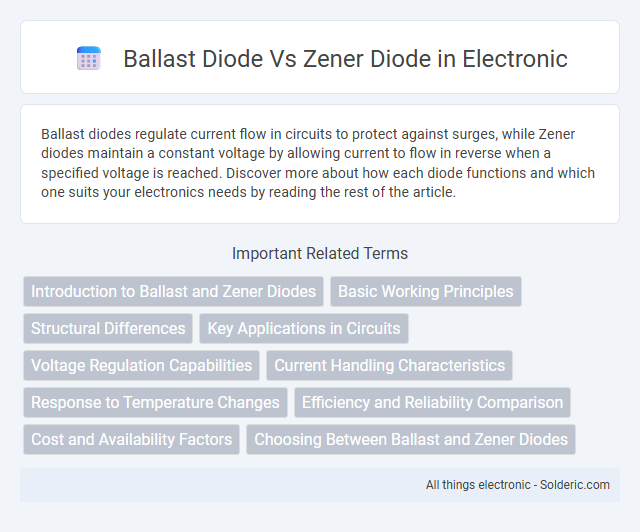Ballast diodes regulate current flow in circuits to protect against surges, while Zener diodes maintain a constant voltage by allowing current to flow in reverse when a specified voltage is reached. Discover more about how each diode functions and which one suits your electronics needs by reading the rest of the article.
Comparison Table
| Feature | Ballast Diode | Zener Diode |
|---|---|---|
| Primary Function | Protects against voltage spikes by limiting current | Voltage regulation by maintaining a constant voltage |
| Operating Mode | Forward biased in normal operation | Operates in reverse breakdown region |
| Voltage Range | Works within normal diode voltage drop (~0.7V for silicon) | Precise, defined breakdown voltages (e.g., 5.1V, 12V) |
| Application | Current limiting in circuits like inductive loads | Voltage reference, voltage regulator, surge protection |
| Construction | Standard PN junction diode | Specially doped diode for sharp reverse breakdown |
| Current Handling | Handles transient current spikes | Maintains steady current at breakdown voltage |
| Example Use Case | Protecting relay coils from voltage spikes | Voltage regulation in power supplies |
Introduction to Ballast and Zener Diodes
Ballast diodes are primarily used in circuits to limit current and protect components by providing a steady voltage drop, often found in power supply applications. Zener diodes regulate voltage by maintaining a stable reference voltage across their terminals, enabling precise voltage control in voltage regulator circuits. Both diodes serve crucial roles in electrical circuits, with ballast diodes focusing on current stabilization and Zener diodes on voltage regulation.
Basic Working Principles
Ballast diodes regulate current by providing a controlled voltage drop, effectively limiting current flow to protect circuits from excessive current. Zener diodes operate by maintaining a constant voltage across their terminals when reverse-biased beyond their breakdown voltage, ensuring voltage stabilization in power supplies. Understanding these basic working principles helps you choose the right diode for current regulation or voltage regulation in your electronic designs.
Structural Differences
Ballast diodes are designed with high current capacity and low forward voltage drop, featuring a simple PN junction optimized for controlling current flow in circuits, whereas Zener diodes have a heavily doped PN junction to enable controlled breakdown at specific reverse voltages for voltage regulation. The structural doping concentration in Zener diodes creates a precisely defined breakdown voltage, allowing them to maintain constant voltage, while ballast diodes rely on thermal stability and are built to handle variable current loads without significant voltage change. These structural differences influence their electrical behavior, with ballast diodes primarily used as current limiters and Zener diodes as voltage regulators.
Key Applications in Circuits
Ballast diodes are primarily used in circuits to stabilize current flow and protect LEDs or transistors from excessive current, ensuring safe operation in power supplies and amplifier biasing. Zener diodes serve as voltage regulators and reference components, maintaining a constant voltage level in voltage clamping, surge protection, and voltage reference circuits. Both diodes play critical roles in enhancing circuit reliability by managing voltage and current effectively in their respective applications.
Voltage Regulation Capabilities
Ballast diodes provide voltage regulation by limiting current flow and dropping excess voltage in power supply circuits, protecting components from overcurrent conditions. Zener diodes offer precise voltage regulation through their stable reverse breakdown voltage, maintaining a constant output voltage despite fluctuations in input voltage or load. Your choice depends on whether you need simple current limitation or accurate voltage clamping for stable power delivery.
Current Handling Characteristics
Ballast diodes are designed to handle higher current loads by regulating current flow and preventing damage in power circuits, making them ideal for protecting electronic components under varying load conditions. Zener diodes primarily function for voltage regulation by maintaining a stable voltage level, but they typically manage lower current levels compared to ballast diodes. Understanding these current handling characteristics ensures you select the correct diode type for efficient circuit protection and performance.
Response to Temperature Changes
Ballast diodes exhibit minimal variation in forward voltage with temperature, maintaining consistent current regulation under changing thermal conditions. Zener diodes display a temperature-dependent breakdown voltage, often characterized by a positive or negative temperature coefficient that requires compensation in precision voltage regulation applications. Understanding these thermal response differences is crucial when selecting diodes for circuits subjected to fluctuating temperatures to ensure stable operation.
Efficiency and Reliability Comparison
Ballast diodes provide high efficiency by limiting current with minimal voltage drop, resulting in lower power dissipation compared to Zener diodes, which operate by voltage breakdown and inherently dissipate more power. In terms of reliability, ballast diodes offer robust performance under varying load conditions with less thermal stress, whereas Zener diodes can experience reduced lifespan due to continuous energy dissipation and heat generation during voltage regulation. Selecting a ballast diode enhances circuit efficiency and durability in power regulation, while Zener diodes are better suited for precise voltage clamping despite lower efficiency.
Cost and Availability Factors
Ballast diodes are typically low-cost and widely available due to their simple construction and common use in regulating current in automotive and power supply applications. In contrast, Zener diodes, designed for voltage regulation and overvoltage protection, may come at a slightly higher price point but benefit from extensive availability in various voltage ratings across electronic component distributors. Your choice between these diodes should consider budget constraints and specific application requirements, with ballast diodes often being more economical for current stabilization and Zener diodes preferable for precise voltage regulation needs.
Choosing Between Ballast and Zener Diodes
Choosing between ballast and Zener diodes depends on your circuit requirements: ballast diodes limit current to protect components, commonly used in LED circuits, while Zener diodes regulate voltage by maintaining a stable reference voltage in power supply applications. Understanding the specific role--current limiting versus voltage stabilization--ensures optimal diode selection and circuit performance. Consider your design's voltage tolerance and current flow characteristics to decide the appropriate diode type for reliable operation.
Ballast diode vs Zener diode Infographic

 solderic.com
solderic.com